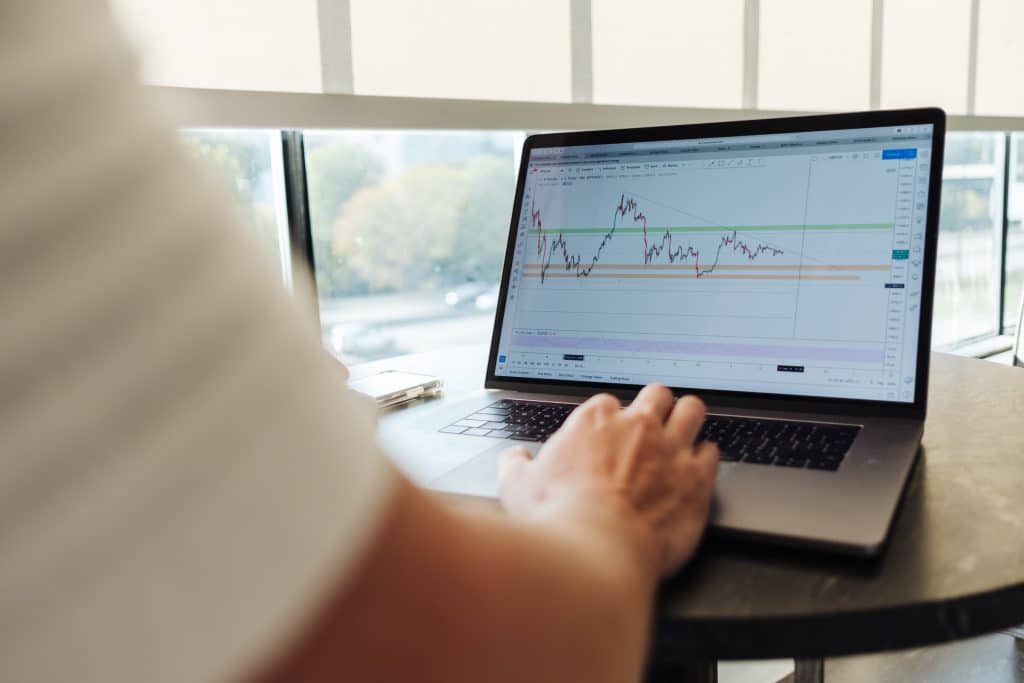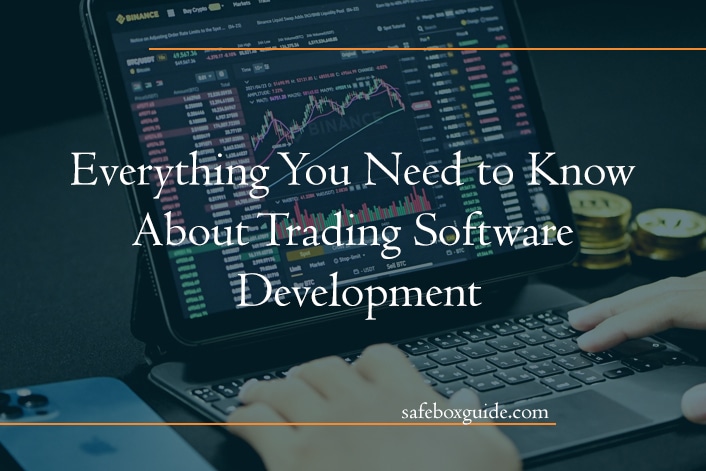Are you looking for ways to boost your trading activities and increase profits? Look no further than trading software development! In today’s fast-paced trading industry, automated solutions are becoming increasingly popular among investors, providing them with a competitive edge in the market. But what exactly is trading software development, and how can it benefit your business?
In this ultimate guide, we’ll dive deep into custom trading software development, exploring its essential aspects and revenue streams, as well as providing tips on how to get started. You’ll learn how trading software solutions can analyze market data, identify profitable opportunities, and execute trades in real time, giving you the ability to make informed decisions quickly and efficiently.

Contents
What is trading software?
Trading software is a type of computer program designed to automate and streamline trading activities. Trading software solutions can analyze market data, identify profitable opportunities, and execute trades in real-time, giving investors the ability to make informed decisions quickly and efficiently.
There are many different types of trading software solutions, each with its own unique features and capabilities. Some trading software solutions are designed for specific markets, such as the stock market, forex market, or cryptocurrency market, while others are more general and can be used for trading across multiple markets.
- Analyze vast amounts of data quickly and efficiently. With the use of advanced algorithms and machine learning, trading software can process large volumes of data in real time, identify market trends, and make informed trading decisions based on historical data and real-time market conditions.
- Range of tools and features to help them manage their trading activities more effectively. For example, trading software solutions may offer charting tools, market analysis tools, and risk management tools to help investors make more informed trading decisions.
- Execute trades automatically. By setting specific criteria and parameters, investors can program their trading software to execute trades automatically when certain market conditions are met. This can save time and effort, as investors do not need to monitor the markets constantly and can rely on the software to execute trades on their behalf.
Trading software development market
The trading software development market has experienced significant growth in recent years, with the increasing popularity of automated trading solutions. Investors are looking for ways to stay ahead of the competition and capitalize on market fluctuations, and trading software development provides them with the tools to do just that.
According to a report by Grand View Research, the global algorithmic trading market size was valued at USD 10.32 billion in 2020 and is expected to reach USD 18.16 billion by 2028, growing at a CAGR of 7.8% during the forecast period. The report cites the increasing demand for automation in trading activities and the need for faster and more efficient trading solutions as key drivers of market growth.
Another factor contributing to the growth of the trading software development market is the increasing popularity of mobile trading applications. Mobile trading apps allow investors to trade on-the-go, providing them with more flexibility and control over their trading activities. As a result, more and more trading software developers are investing in the development of mobile trading apps to cater to the growing demand.
The rise of cryptocurrencies has also had a significant impact on the trading software development market. With the increasing popularity of digital currencies, there has been a surge in demand for trading software solutions that can support cryptocurrency trading. As a result, many trading software developers are now offering cryptocurrency trading features in their software solutions.
Why should businesses invest in trading software development?
Trading software development can generate revenue for your business in several ways. Below are some of the primary ways in which trading software can make money for your business:
- Software licensing fees: One of the most common ways that trading software developers generate revenue is by charging licensing fees for their software. Trading software solutions are often sold on a subscription basis, with investors paying a monthly or annual fee to use the software.
- Commission fees: The crypto wallet development company implements trading software solutions to charge commission fees for each trade executed through the software. These fees can be a percentage of the trade value or a flat fee per trade.
- custom development for finance and fintech: Trading software development companies may offer custom development services to clients who require specialized trading software solutions. These services can generate revenue through one-time development fees or ongoing maintenance fees.
- Partnership programs: Trading software developers may partner with other companies to offer their software solutions as part of a broader package of services. In such cases, the trading software developer may receive a percentage of the revenue generated by the partnership.
- Advertising and sponsorship: Some trading software solutions may generate revenue through advertising and sponsorship deals. For example, a trading software developer may partner with a financial news website to offer their software solutions to readers, with the developer paying the website a fee for each new user that signs up.
6 things you need to know about trading software development
Trading software development is a complex process that involves several essential aspects. These aspects include:
- Market research and analysis: Before starting the development process, it is crucial to conduct extensive market research and analysis to identify the target market and understand the needs and requirements of potential users. This research can help inform the development process and ensure that the resulting trading software solution is tailored to the needs of its users.
- User interface design: The user interface of the trading software solution is critical in ensuring a positive user experience. The user interface should be intuitive, easy to use, and visually appealing, providing users with the information and tools they need to make informed trading decisions.
- Algorithm development: The algorithms used in trading software solutions are at the heart of their functionality. These algorithms should be developed with care, taking into account factors such as historical data, market trends, and real-time market conditions, to ensure that the trading software can identify profitable opportunities and execute trades quickly and efficiently.
- Risk management: Trading software solutions should include robust risk management features to help investors manage their exposure to risk effectively. These features can include stop-loss orders, position sizing tools, and other risk management tools to help investors limit their losses and maximize their profits.
- Security: Security is essential in trading software solutions, as they often deal with sensitive financial information. Trading software developers must implement robust security measures to ensure that user data is protected from unauthorized access or theft.
- Testing and optimization: Before releasing the trading software solution to the market, it is crucial to conduct extensive testing and optimization to ensure that it performs as intended. This testing can involve backtesting the algorithms used in the software, testing the user interface for usability and functionality, and optimizing the software for speed and efficiency.

Where to start trading software development?
Developing trading software can be a challenging task, but with the right approach and tools, it is possible to create effective and reliable trading software solutions. Below are some instructions and tips on where to start and how to develop trading software:
- Identify the target market and user needs: Before starting the development process, it is essential to identify the target market and understand the needs and requirements of potential users. This can involve conducting market research and analysis, surveying potential users, and identifying key features and functionalities required in the trading software solution.
- Select the appropriate programming language and tools: The programming language and tools used in trading software development will depend on the specific requirements of the trading software solution. Popular programming languages for trading software development include Java, Python, and C++. Developers should also consider using specialized trading software development frameworks and libraries to speed up the development process.
- Develop the user interface: The user interface of the trading software solution should be intuitive, easy to use, and visually appealing. Developers should take into account the needs and requirements of users when designing the user interface and should test the interface for usability and functionality.
- Develop the algorithms: The algorithms used in trading software solutions are critical in identifying profitable trading opportunities and executing trades quickly and efficiently. Developers should take care when developing algorithms, considering factors such as historical data, market trends, and real-time market conditions.
- Implement risk management features: Trading software solutions should include robust risk management features to help investors manage their exposure to risk effectively. These features can include stop-loss orders, position sizing tools, and other risk management tools to help investors limit their losses and maximize their profits.
- Test and optimize the trading software solution: Before releasing the trading software solution to the market, it is crucial to conduct extensive testing and optimization to ensure that it performs as intended. This testing can involve backtesting the algorithms used in the software, testing the user interface for usability and functionality, and optimizing the software for speed and efficiency.
Conclusion
Trading software development is a complex and challenging process that requires careful planning, attention to detail, and a deep understanding of the needs and requirements of potential users. However, by following the essential aspects of trading software development, selecting the appropriate programming language and tools, developing the user interface, algorithms, and risk management features, and testing and optimizing the trading software solution, developers can create effective and reliable trading software solutions that generate revenue for their businesses.

